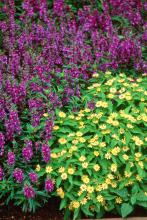Information Possibly Outdated
The information presented on this page was originally released on February 16, 2006. It may not be outdated, but please search our site for more current information. If you plan to quote or reference this information in a publication, please check with the Extension specialist or author before proceeding.
Two new angelonias can spice up summer gardens
By Norman Winter
MSU Horticulturist
Central Mississippi Research & Extension Center
Thanks to the new Serena series and a new compact called Angel Mist, angelonias should finally reach star status in Southern landscapes.
Maybe that's wishful thinking because my recent surveys at seminars point to a disturbing fact -- gardeners still haven't tried angelonias and probably don't understand what they are.
I first wrote about the angelonia in 1997 and have written about it and shown it on Southern Gardening TV several times since then. Perhaps the word angelonia is unfamiliar compared to words like petunia or marigold. As I write this, my computer software underlines the word angelonia, meaning it doesn't recognize it. It doesn't do that with zinnia or geranium.
Think of the angelonia as a snapdragon that blooms all summer and with a little deadheading, will still be blooming at fall frost. It is related to the snapdragon but instead of wilting or deteriorating when it starts to cook outside, it simply gets better.
The Angel Mist series has been out for a few years, but Ball FloraPlant has been tirelessly working to bring you a superior plant. Now we have the compact version. Some who tried angelonias in the past didn't like the fact that they reached 24 to 30 inches tall and developed a lanky look by August.
If you were in that group, you will love the new compact Angel Mist angelonias that will stay around 15 to 18 inches tall and bloom longer before they need to be deadheaded.
If you like compact, controlled plants, you will love the new Serena series even more. The Serena angelonias come in four colors and only reach 10 to 12 inches tall, but they spread 12 to 14 inches. These have received outstanding ratings all across the country and were impressive in our trials as well.
You've got to give the angelonia a try in your flower border. Their spiky flowers are a welcome sight in the world where round flowers seem to dominate.
Plant them in well-drained, well-prepared beds rich in organic matter. Choose a site in full sun for best flowering. It is hard to believe that a plant in the snapdragon family relishes our summer heat and humidity.
Once established in the bed, angelonias seem to have remarkable drought tolerance. This is particularly true in organic-rich beds where a layer of mulch has been added. They need supplemental irrigation if we should go through a prolonged dry spell. Please do not stick this wonderful plant in tight, cement-like soil.
A light, monthly application of a 2-1-2-ratio fertilizer, such as a 10-5-10 with minor nutrients, is all this plant needs to keep blooming. The bloom period is really long, and when it does want to cycle, it responds well to trimming back with a pair of pruning shears.
Blooming angelonias look like they would be at home in a cottage garden. They are not as tall as the larkspur, and they look good with New Gold lantana or planted in drifts adjacent to black-eyed Susans. The white and pink varieties look awesome planted in front of tall, purple coneflowers.
I have only mentioned Serena and the Angel Mist compact selections, but there are other varieties worth trying such as the Carita and the Angel Mist series. Regardless of the angelonias you choose, rest assured that you are getting one of the best new flowers. Look for angelonias this spring at your garden center. You will love them.



